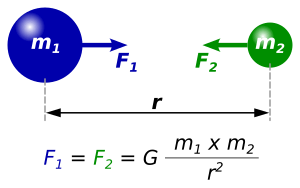Gravitational constant facts for kids

The gravitational constant is a very important number in physics. It helps us understand how strong the force of gravity is between any two objects. Scientists call this constant G.
This special number, G, is about 6.67430 with 11 zeros after the decimal point (0.0000000000667430) N⋅m2/kg2. It's often called the universal gravitational constant or Newton's constant. Some people even call it Big G to make it sound friendly!
G is a key part of Isaac Newton's famous law of universal gravitation. It also appears in Albert Einstein's general theory of relativity.
It's important not to confuse Big G with small g (g). Small g is about the gravity you feel on Earth. It's why things fall down when you drop them. Big G is about gravity everywhere in the universe, between any two objects, no matter how big or small.
Contents
What is the Gravitational Constant?
The gravitational constant, G, is a number that scientists have measured very carefully. It tells us the exact strength of gravity. Imagine you have two objects, like two planets or even two apples. The gravitational constant helps us calculate how much they pull on each other.
This constant is "universal" because it's believed to be the same everywhere in the universe. Whether you are on Earth, Mars, or a distant galaxy, the value of G remains the same.
How is G Used?
G is used in a famous formula by Isaac Newton. This formula helps us figure out the gravitational force between any two objects. The formula looks like this:
F = G * (m1 * m2) / r2
- F is the gravitational force (how strong the pull is).
- G is the gravitational constant (our special number!).
- m1 and m2 are the masses of the two objects (how much "stuff" they have).
- r is the distance between the centers of the two objects.
So, the bigger the objects (more mass) and the closer they are, the stronger the gravitational pull will be!
Who Discovered it?
While Isaac Newton first described the law of universal gravitation, he didn't actually measure the exact value of G. The first person to measure G accurately was a scientist named Henry Cavendish in 1798. He used a special device called a torsion balance to do this.
Later, Albert Einstein used the gravitational constant in his own groundbreaking theory of gravity, called the general theory of relativity. This theory describes gravity not just as a force, but as a curve in space and time caused by massive objects.
Images for kids
See also
 In Spanish: Constante de gravitación universal para niños
In Spanish: Constante de gravitación universal para niños


